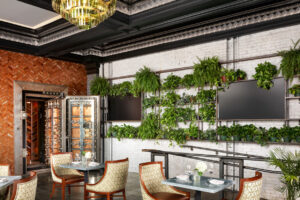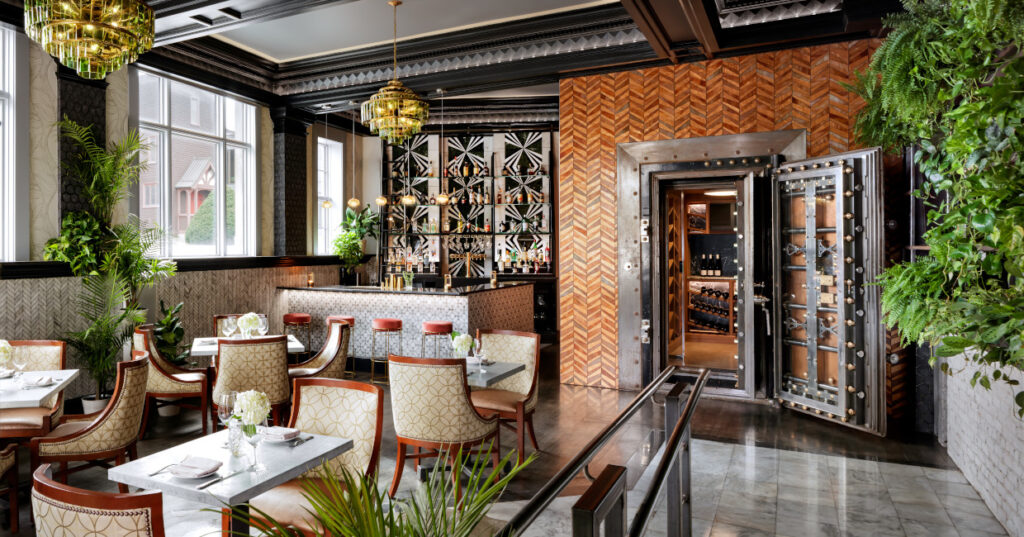What was once Old Town, Maine’s iconic Eastern Trust Bank, has been transformed into a lively “old world” speakeasy. Designed by Ervin Architecture (EA), the Trust Room is a historic restoration project that took design cues from surviving original remnants of a corner building that prominently serves as a gateway into downtown, an area climbing back into relevancy. Once tethered to the booming lumber industry of nearby Bangor, Maine, local developers are looking to put Old Town back on the map, and owner Alex Gray has added yet another impressive building to this comprehensive rehabilitation effort.
Led by EA’s expertise in creative adaptive reuse solutions, this project continues the design firm’s tradition of preserving a building’s history while creating bold, impactful design solutions that give old landmarks new relevancy. As is all too common in the boom-to-bust cycle of many American cities and towns, the once bustling Eastern Trust Bank’s demise represented a trend for the entire downtown and the region as a whole.
Unsurprisingly, following a long period of neglect and short-sighted construction, the building was in rough shape. From the outset, EA placed significant value on unearthing the building’s historic features and restoring them. With great caution, the team restored the ceiling moldings and dentals, column capitals, and window trim. EA embraced the building’s original Neoclassical character, restoring elements such as palladium windows, plasterwork, and brickwork. As these details emerged more clearly as the restoration continued, a speakeasy concept with a contemporary spark emerged.
 The phrase “adaptive reuse” is often taken at face value, but EA’s unique approach looks at the term “adaptive” through the lens of adapting the design program to the original character of the building rather than adapting the building to a preconceived programmatic intention. The interplay between protecting historic precedent while establishing a new aesthetic identity hallmarks EA’s approach, giving the original flavour of the building an ability to persist and flourish again.
The phrase “adaptive reuse” is often taken at face value, but EA’s unique approach looks at the term “adaptive” through the lens of adapting the design program to the original character of the building rather than adapting the building to a preconceived programmatic intention. The interplay between protecting historic precedent while establishing a new aesthetic identity hallmarks EA’s approach, giving the original flavour of the building an ability to persist and flourish again.
For example, a portion of the floor is still inlaid with stone tile from the original bank teller entry desk. EA restored and sealed them, ultimately incorporating this element into the new tapestry that stitched the building’s history together with its new reimagined identity. In a similar vein, EA converted a historic walk-in bank vault into a temperature-controlled wine cuvee with custom reclaimed mahogany cabinetry.
This conversation continued with the dialogue between restored historic details, era appropriate elements, and bright contemporary colours and patterns which ultimately became the signature trademark of the space. The “old world” design choices, including marble wall tile, brass finishes, crystal chandeliers, and velvet upholstery combined to thoughtfully reference the original era of the building while working alongside a new aesthetic course established by furniture fabrics, glass wall tile, and geometric patterned wallpapers. The result is a stunning atmosphere mixing old and new that leaves patrons with a lasting impression of a building that spans nearly 100 years of architectural history.
The complete program includes a new entry vestibule, a ramped handicap access, wood-fired kitchen, new handicap accessible bathrooms, a secret speakeasy door from an adjacent restaurant, and a prefabricated Tobin Ellis bar. Additionally, the Trust Room showcases an eye-catching plant wall that faces large street-level historic windows. The wall’s leafy inhabitants live in stark contrast to the textured whitewashed brick wall behind them. Beyond the lush organic mosaic that is created, the plants actually inhale toxins out of the air and exhaust oxygen––making a noticeable impact on the air quality and cultivating an experience that prioritises wellbeing.
The Trust Room is another example of how Ervin Architecture’s creative design solutions serve as a robust economic catalyst for towns looking to regain economic footing. It also is part of a national trend of communities moving back into the Central Business District from the suburban sprawl of the 80s and 90s, placing value on what a bustling downtown might represent for them. Restoring the downtown of Old Town Maine was the focus of city officials from the outset of this project, and the owner of the building answered their call with a significant investment. This initiative created a measurable draw to the downtown, promoted the walkability of Old Town by reviving the liveliness of the downtown area, encouraged guests to support other nearby downtown businesses, and continues to celebrate the city’s cultural identity as a town with a history worth protecting and a future worth investing in.



